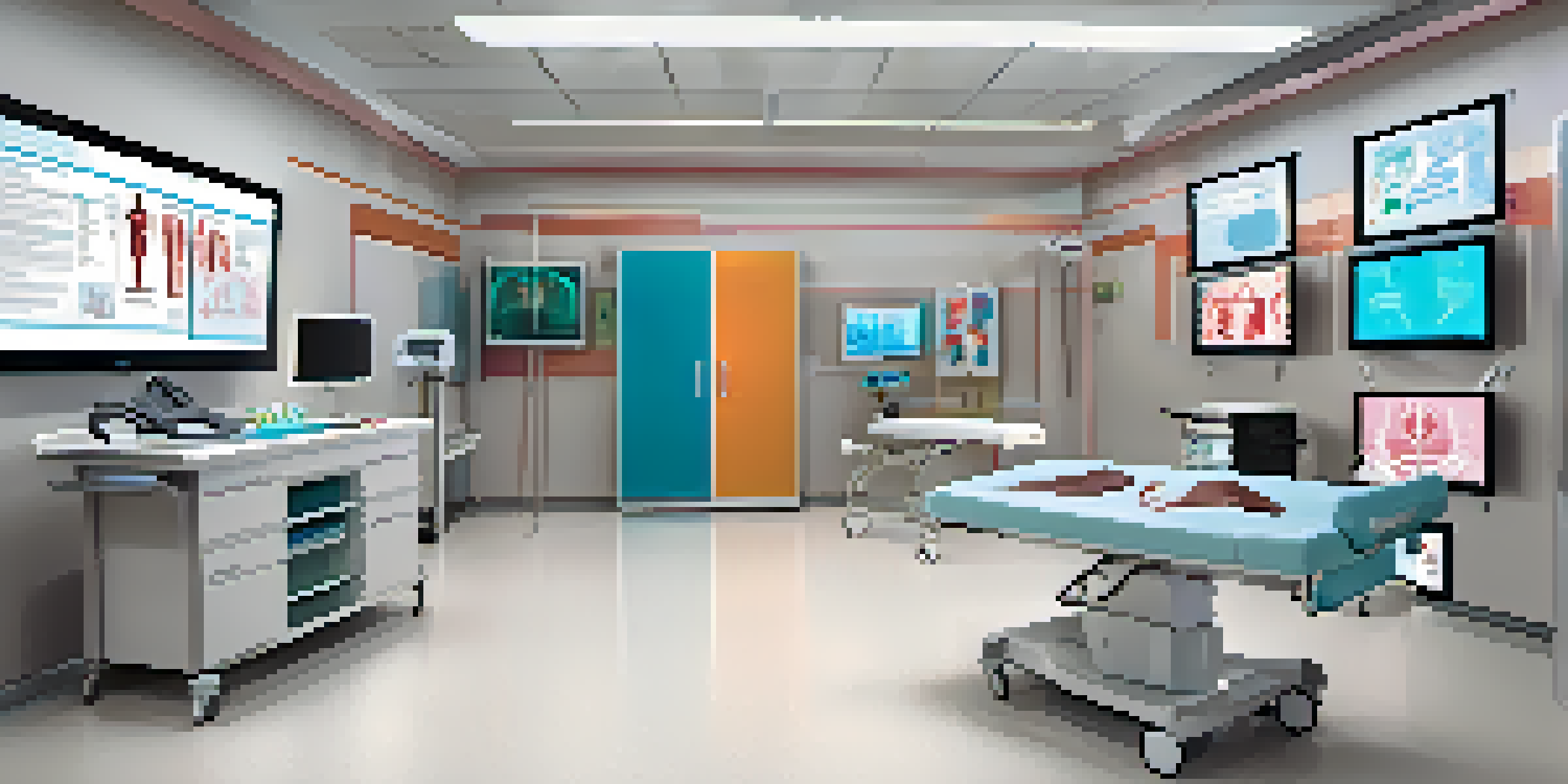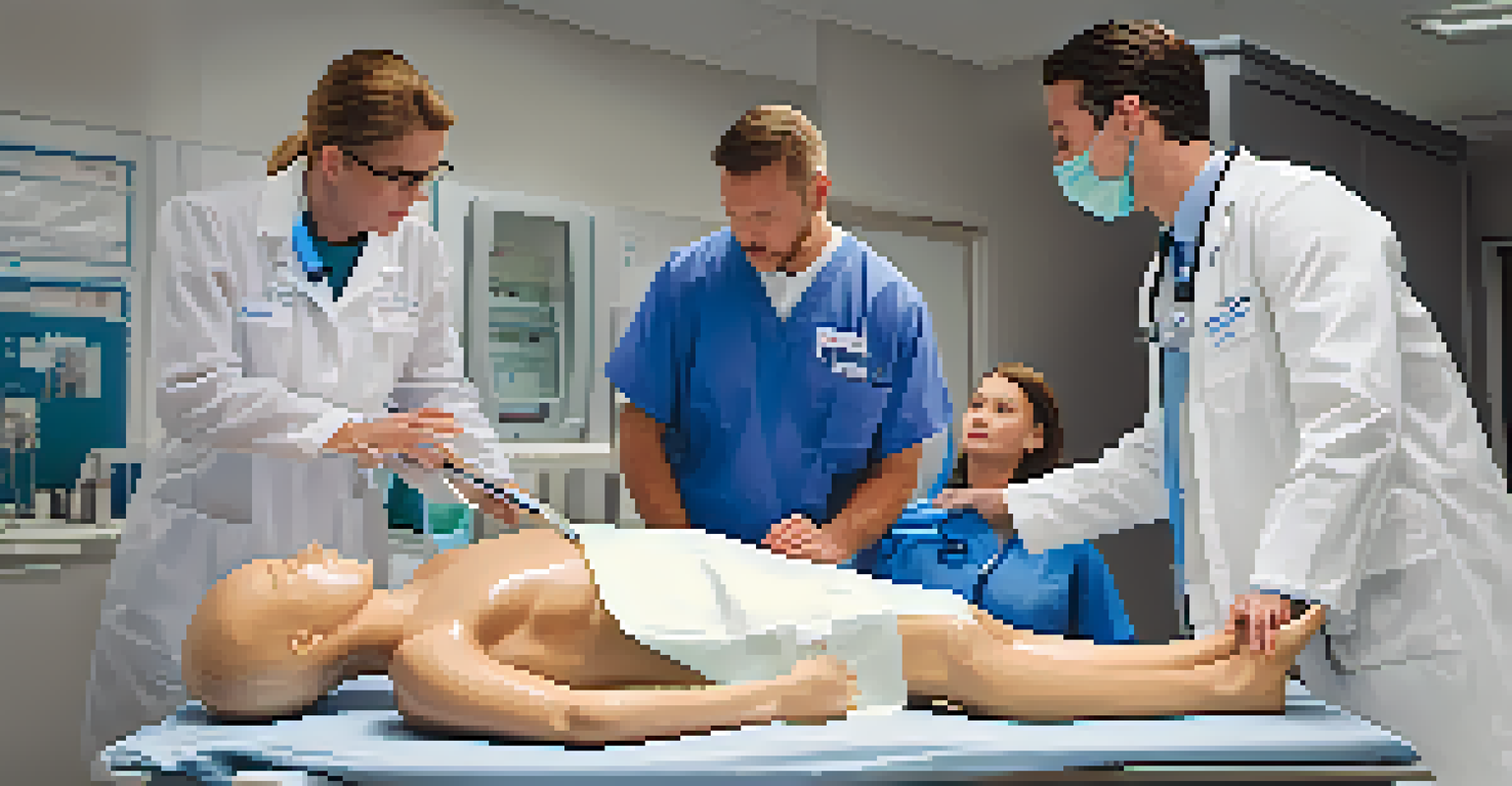Benefits of Simulation Technology in Healthcare Training

What is Simulation Technology in Healthcare Training?
Simulation technology in healthcare training refers to the use of advanced tools and techniques to replicate real-life clinical scenarios. These simulations can range from virtual reality environments to high-fidelity mannequins that mimic human responses. By creating these realistic settings, healthcare professionals can practice their skills without the risks associated with real patients.
The use of simulation in training can not only improve skills but also reduce errors and enhance patient safety.
Imagine a pilot training in a flight simulator before flying an actual plane; similarly, healthcare professionals use simulation to refine their techniques. This hands-on experience allows them to learn from mistakes in a controlled setting, ultimately leading to better patient outcomes. In essence, simulation technology provides a safe playground for medical training.
As the healthcare landscape continues to evolve, the importance of such training methods becomes increasingly clear. With ongoing advancements in technology, simulations are becoming more sophisticated, making them an essential component of modern medical education.
Enhancing Skill Development Through Simulation
One of the most significant advantages of simulation technology is its ability to enhance skill development among healthcare professionals. By engaging in realistic scenarios, learners can practice clinical skills repeatedly until they achieve proficiency. This repetitive practice builds confidence and competence, which are crucial when they eventually care for real patients.

For example, a nurse can practice administering injections or handling emergency situations in a simulated environment before interacting with actual patients. This not only reduces anxiety in high-pressure situations but also ensures that they are well-prepared for a variety of clinical challenges. The more they practice, the better they perform.
Boosting Skills Through Simulation
Simulation technology allows healthcare professionals to practice clinical skills in realistic environments, enhancing their confidence and competence.
Moreover, simulation allows for immediate feedback, which is vital for effective learning. Instructors can analyze a trainee's actions during a simulation and provide constructive critiques, ensuring that mistakes are addressed before they occur in real life.
Improving Teamwork and Communication Skills
Simulation technology also plays a crucial role in improving teamwork and communication within healthcare settings. Many medical scenarios require coordinated efforts from various professionals, such as doctors, nurses, and technicians. Simulated environments foster collaboration, enabling teams to practice their communication skills in realistic situations.
Simulation-based training is a powerful tool that allows healthcare professionals to practice critical skills in a safe environment.
Consider a surgical team navigating a complex procedure; their ability to communicate effectively can make the difference between success and failure. Through simulation, team members learn how to convey critical information quickly and efficiently, which translates to better patient care. This collaborative practice is essential for building trust and understanding among team members.
Furthermore, these simulations often expose teams to challenging scenarios that require swift decision-making and adaptability. By practicing together, healthcare professionals can develop a cohesive approach to patient care, ultimately leading to enhanced outcomes.
Fostering Critical Thinking and Decision-Making
Another key benefit of simulation technology is its ability to foster critical thinking and decision-making skills among healthcare trainees. In simulated scenarios, learners are often faced with unexpected challenges that require quick assessments and problem-solving. This helps cultivate a mindset that is essential for navigating the complexities of real-world healthcare situations.
For instance, a trainee might encounter a patient with ambiguous symptoms during a simulation. They must analyze the information, prioritize actions, and make informed decisions under pressure. This type of scenario encourages learners to think on their feet and develop strategies for effective patient management.
Improving Teamwork and Safety
Through simulated scenarios, healthcare teams can enhance communication and collaboration, which ultimately reduces medical errors and improves patient safety.
By engaging in these high-stakes environments, healthcare professionals become adept at evaluating situations critically and making sound decisions. This not only enhances their skills but also contributes to a culture of safety and accountability in healthcare settings.
Reducing Medical Errors and Enhancing Patient Safety
One of the most compelling reasons to incorporate simulation technology in healthcare training is its potential to reduce medical errors and enhance patient safety. As trainees practice in simulations, they learn to recognize and mitigate risks before they occur in real-life situations. This proactive approach is vital in preventing mistakes that could have serious consequences.
For instance, through simulations, healthcare professionals can practice identifying medication errors or managing emergency responses. By addressing these critical scenarios in a safe environment, they are better equipped to handle similar situations in real life, thus improving overall patient safety.
The implications of this training extend beyond individual practitioners; they contribute to a culture of safety within healthcare organizations. As teams become more skilled and confident in their abilities, the likelihood of errors diminishes, ultimately leading to improved patient outcomes.
Cost-Effectiveness of Simulation Training
While implementing simulation technology may seem like a significant investment, it can actually lead to considerable cost savings in the long run. By reducing medical errors and improving patient outcomes, healthcare organizations can avoid the financial repercussions associated with malpractice suits and prolonged hospital stays. Simulation training ultimately pays for itself by minimizing these risks.
Additionally, simulation allows for more efficient use of resources. Traditional training methods often require live patients or extensive materials, whereas simulations can be conducted with minimal costs and set-up time. This efficiency means that more trainees can benefit from high-quality training without straining budgets.
Cost-Effective Training Solutions
Investing in simulation training can lead to significant long-term cost savings by reducing malpractice risks and improving patient outcomes.
Moreover, the ability to train multiple individuals simultaneously in a simulation setting maximizes the use of available resources. This not only enhances the learning experience for trainees but also ensures that healthcare facilities can maintain high standards of care, all while keeping costs manageable.
Adapting to Technological Advances in Healthcare
As technology continues to advance, healthcare training must evolve alongside it. Simulation technology is at the forefront of this evolution, providing a platform for healthcare professionals to stay updated on the latest practices and techniques. This adaptability is crucial in a field where new treatments and technologies are constantly being introduced.
For example, virtual reality simulations can recreate new surgical techniques or procedures, allowing trainees to familiarize themselves with these advancements before applying them in real-life scenarios. This not only ensures that healthcare professionals remain competent but also instills confidence in their ability to utilize cutting-edge technology.

Incorporating simulation training into healthcare education prepares professionals for a rapidly changing landscape. As they become accustomed to using advanced technologies in a controlled environment, they are better equipped to embrace the future of healthcare.
Conclusion: The Future of Healthcare Training with Simulation
In conclusion, the benefits of simulation technology in healthcare training are numerous and impactful. From enhancing skill development and teamwork to reducing medical errors and adapting to technological advancements, simulation serves as a cornerstone for modern medical education. It equips healthcare professionals with the necessary tools to provide high-quality patient care.
As we look to the future, it is clear that simulation technology will play an increasingly vital role in shaping the next generation of healthcare providers. By embracing these advanced training methods, we can ensure that healthcare professionals are not only well-prepared but also confident in their abilities to deliver exceptional care.
Ultimately, investing in simulation training means investing in the health and safety of patients. As healthcare continues to evolve, so must our training methods, and simulation technology is leading the way.